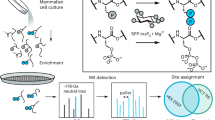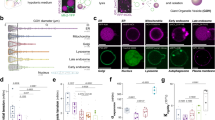Abstract
Transport vesicles mediate protein traffic between endomembrane organelles in a highly selective and efficient manner. In vitro reconstitution systems have been widely used for studying mechanisms of vesicle formation, polar trafficking, and cargo specificity in mammals and yeast. However, this technique has not yet been applied to plants because of the large lytic vacuoles and rigid cell walls. Here, we describe an Arabidopsis-derived in vitro vesicle formation system to reconstitute, purify and characterize plant-derived coat protein complex II (COPII) vesicles. In this protocol, we provide a detailed method for the isolation of microsomes and cytosol from Arabidopsis thaliana suspension-cultured cells (7–8 h), in vitro COPII vesicle reconstitution and purification (4–5 h) and biochemical and microscopic analysis using specific antibodies against COPII cargo molecules for reconstitution efficiency evaluation (2 h). We also include detailed sample-preparation steps for analyzing vesicle morphology by cryogenic electron microscopy (1 h) and vesicle cargoes by quantitative proteomics (4 h). Routinely, the whole procedure takes ~18–20 h of operation time and enables plant researchers without specific expertise to achieve organelle purification or vesicle reconstitution for further characterization.
This is a preview of subscription content, access via your institution
Access options
Access Nature and 54 other Nature Portfolio journals
Get Nature+, our best-value online-access subscription
$29.99 / 30 days
cancel any time
Subscribe to this journal
Receive 12 print issues and online access
$259.00 per year
only $21.58 per issue
Buy this article
- Purchase on Springer Link
- Instant access to full article PDF
Prices may be subject to local taxes which are calculated during checkout




Similar content being viewed by others
Data availability
Raw data needed to generate the figures presented in this work are available in the source data files. Source data are provided with this paper.
References
Fries, E. & Rothman, J. E. Transport of vesicular stomatitis virus glycoprotein in a cell-free extract. Proc. Natl Acad. Sci. USA 77, 3870–3874 (1980).
Beckers, C. J., Keller, D. S. & Balch, W. E. Semi-intact cells permeable to macromolecules: use in reconstitution of protein transport from the endoplasmic reticulum to the Golgi complex. Cell 50, 523–534 (1987).
Baker, D., Hicke, L., Rexach, M., Schleyer, M. & Schekman, R. Reconstitution of SEC gene product-dependent intercompartmental protein transport. Cell 54, 335–344 (1988).
Hicke, L. & Schekman, R. Yeast Sec23p acts in the cytoplasm to promote protein transport from the endoplasmic reticulum to the Golgi complex in vivo and in vitro. EMBO J. 8, 1677–1684 (1989).
Barlowe, C. et al. COPII: a membrane coat formed by Sec proteins that drive vesicle budding from the endoplasmic reticulum. Cell 77, 895–907 (1994).
Bednarek, S. Y. et al. COPI- and COPII-coated vesicles bud directly from the endoplasmic reticulum in yeast. Cell 83, 1183–1196 (1995).
Matsuoka, K. et al. COPII-coated vesicle formation reconstituted with purified coat proteins and chemically defined liposomes. Cell 93, 263–275 (1998).
Rowe, T. et al. COPII vesicles derived from mammalian endoplasmic reticulum microsomes recruit COPI. J. Cell Biol. 135, 895–911 (1996).
Aridor, M., Weissman, J., Bannykh, S., Nuoffer, C. & Balch, W. E. Cargo selection by the COPII budding machinery during export from the ER. J. Cell Biol. 141, 61–70 (1998).
Melville, D., Gorur, A. & Schekman, R. Fatty-acid binding protein 5 modulates the SAR1 GTPase cycle and enhances budding of large COPII cargoes. Mol. Biol. Cell 30, 387–399 (2019).
Gorur, A. et al. COPII-coated membranes function as transport carriers of intracellular procollagen I. J. Cell Biol. 216, 1745–1759 (2017).
Chen, X. W. et al. SEC24A deficiency lowers plasma cholesterol through reduced PCSK9 secretion. Elife 2, e00444 (2013).
Merte, J. et al. Sec24b selectively sorts Vangl2 to regulate planar cell polarity during neural tube closure. Nat. Cell Biol. 12, 41–46 (2010).
Fromme, J. C. et al. The genetic basis of a craniofacial disease provides insight into COPII coat assembly. Dev. Cell 13, 623–634 (2007).
Boyadjiev, S. A. et al. Cranio-lenticulo-sutural dysplasia is caused by a SEC23A mutation leading to abnormal endoplasmic-reticulum-to-Golgi trafficking. Nat. Genet. 38, 1192–1197 (2006).
Ma, T. et al. A mechanism for differential sorting of the planar cell polarity proteins Frizzled6 and Vangl2 at the trans-Golgi network. J. Biol. Chem. 293, 8410–8427 (2018).
Huang, Y. et al. An in vitro vesicle formation assay reveals cargo clients and factors that mediate vesicular trafficking. Proc. Natl Acad. Sci. U. S. A. 118, e2101287118 (2021).
Brier, L. W., Zhang, M. & Ge, L. Mechanistically dissecting autophagy: insights from in vitro reconstitution. J. Mol. Biol. 428, 1700–1713 (2016).
Adolf, F. et al. Proteomic profiling of mammalian COPII and COPI vesicles. Cell Rep. 26, 250–265.e5 (2019).
Robinson, D. G., Brandizzi, F., Hawes, C. & Nakano, A. Vesicles versus tubes: is endoplasmic reticulum-Golgi transport in plants fundamentally different from other eukaryotes? Plant Physiol. 168, 393–406 (2015).
Chung, K. P., Zeng, Y. & Jiang, L. COPII paralogs in plants: functional redundancy or diversity? Trends Plant Sci. 21, 758–769 (2016).
Pimpl, P. et al. In situ localization and in vitro induction of plant COPI-coated vesicles. Plant Cell 12, 2219–2236 (2000).
Li, B. et al. A distinct giant coat protein complex II vesicle population in Arabidopsis thaliana. Nat. Plants 7, 1335–1346 (2021).
Yokota, E. et al. Myosin XI-dependent formation of tubular structures from endoplasmic reticulum isolated from tobacco cultured BY-2 cells. Plant Physiol. 156, 129–143 (2011).
Miao, Y. & Jiang, L. Transient expression of fluorescent fusion proteins in protoplasts of suspension cultured cells. Nat. Protoc. 2, 2348–2353 (2007).
Hudson, R. T. & Draper, R. K. Interaction of coatomer with aminoglycoside antibiotics: evidence that coatomer has at least two dilysine binding sites. Mol. Biol. Cell 8, 1901–1910 (1997).
Muniz, M., Morsomme, P. & Riezman, H. Protein sorting upon exit from the endoplasmic reticulum. Cell 104, 313–320 (2001).
Espenshade, P. J., Li, W. P. & Yabe, D. Sterols block binding of COPII proteins to SCAP, thereby controlling SCAP sorting in ER. Proc. Natl Acad. Sci. U. S. A. 99, 11694–11699 (2002).
Adolf, F., Rhiel, M., Reckmann, I. & Wieland, F. T. Sec24C/D-isoform-specific sorting of the preassembled ER-Golgi Q-SNARE complex. Mol. Biol. Cell 27, 2697–2707 (2016).
Xu, D. & Hay, J. C. Reconstitution of COPII vesicle fusion to generate a pre-Golgi intermediate compartment. J. Cell Biol. 167, 997–1003 (2004).
Hobman, T. C., Zhao, B., Chan, H. & Farquhar, M. G. Immunoisolation and characterization of a subdomain of the endoplasmic reticulum that concentrates proteins involved in COPII vesicle biogenesis. Mol. Biol. Cell 9, 1265–1278 (1998).
Drakakaki, G. et al. Isolation and proteomic analysis of the SYP61 compartment reveal its role in exocytic trafficking in Arabidopsis. Cell Res. 22, 413–424 (2012).
Wattelet-Boyer, V. et al. Enrichment of hydroxylated C24- and C26-acyl-chain sphingolipids mediates PIN2 apical sorting at trans-Golgi network subdomains. Nat. Commun. 7, 12788 (2016).
Bacia, K. et al. Multibudded tubules formed by COPII on artificial liposomes. Sci. Rep. 1, 17 (2011).
Zanetti, G. et al. The structure of the COPII transport-vesicle coat assembled on membranes. Elife 2, e00951 (2013).
Reynolds, G. D., August, B. & Bednarek, S. Y. Preparation of enriched plant clathrin-coated vesicles by differential and density gradient centrifugation. Methods Mol. Biol. 1209, 163–177 (2014).
Mosesso, N., Blaske, T., Nagel, M. K., Laumann, M. & Isono, E. Preparation of clathrin-coated vesicles from Arabidopsis thaliana seedlings. Front. Plant Sci. 9, 1972 (2018).
Dahhan, D. A. et al. Proteomic characterization of isolated Arabidopsis clathrin-coated vesicles reveals evolutionarily conserved and plant-specific components. Plant Cell 34, 2150–2173 (2022).
Wang, J. et al. Protein mobilization in germinating mung bean seeds involves vacuolar sorting receptors and multivesicular bodies. Plant Physiol. 143, 1628–1639 (2007).
Tse, Y. C. et al. Identification of multivesicular bodies as prevacuolar compartments in Nicotiana tabacum BY-2 cells. Plant Cell 16, 672–693 (2004).
Bradford, M. M. A rapid and sensitive method for the quantitation of microgram quantities of protein utilizing the principle of protein-dye binding. Anal. Biochem. 72, 248–254 (1976).
Acknowledgements
The authors thank R. Schekman, A. Gorur and D. G. Robinson for critical suggestions; D. Inzé for the PSB-D suspension cultures; X. Wang for sharing experiences on fractionation and cytosol preparation; and Y. Chen for microscopic images. This work was supported by grants from the National Natural Science Foundation of China (91854201), the Research Grants Council of Hong Kong (CUHK14100818, 14101219, C4033-19E, C4002-17G, C4002-20W, C4002-21EF, C2009-19G, C4041-18E, R4005-18 and AoE/M-05/12), the CUHK Research Committee and CAS-Croucher Funding Scheme for Joint Laboratories to L.J.
Author information
Authors and Affiliations
Contributions
B.L. and Y.Z. conceived and designed the study. B.L. and Y.Z. developed the protocol. B.L., Y.Z., S.W.L. and Y.G. performed the experiments. B.L. and Y.Z. wrote the manuscript. L.J. revised and edited the manuscript.
Corresponding author
Ethics declarations
Competing interests
The authors declare no competing interests.
Peer review
Peer review information
Nature Protocols thanks Fernando Aniento, Liang Ge and the other, anonymous, reviewer(s) for their contribution to the peer review of this work.
Additional information
Publisher’s note Springer Nature remains neutral with regard to jurisdictional claims in published maps and institutional affiliations.
Related links
Key reference using this protocol:
Li, B. et al. Nat. Plants 7, 1335–1346 (2021): https://doi.org/10.1038/s41477-021-00997-9
Supplementary information
Source data
Source Data Fig. 1
Uncropped confocal images for Fig. 1c
Source Data Fig. 2
Uncropped confocal images for Fig. 2b
Source Data Fig. 3
Uncropped TEM image for Fig. 3c
Rights and permissions
Springer Nature or its licensor (e.g. a society or other partner) holds exclusive rights to this article under a publishing agreement with the author(s) or other rightsholder(s); author self-archiving of the accepted manuscript version of this article is solely governed by the terms of such publishing agreement and applicable law.
About this article
Cite this article
Li, B., Zeng, Y., Lo, S.W. et al. In vitro reconstitution of COPII vesicles from Arabidopsis thaliana suspension-cultured cells. Nat Protoc 18, 810–830 (2023). https://doi.org/10.1038/s41596-022-00781-9
Received:
Accepted:
Published:
Issue Date:
DOI: https://doi.org/10.1038/s41596-022-00781-9
Comments
By submitting a comment you agree to abide by our Terms and Community Guidelines. If you find something abusive or that does not comply with our terms or guidelines please flag it as inappropriate.



